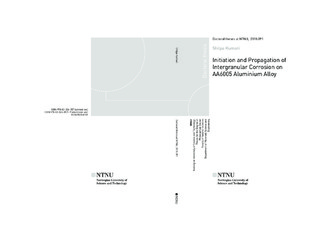| dc.description.abstract | The increasing use of 6xxx series aluminium alloys (AlMgSi) in automotive applications is due to its high strength to weight ratio (enabling substantially reduced fuel consumption and CO2 emissions than for heavier materials in use today), good extrudability and overall good corrosion resistance. Even though the 6xxx series are considered resistant to intergranular corrosion (IGC), these alloys may develop susceptibility due to unfavourable alloying and thermomechanical treatment. The objective of this thesis is to understand the mechanisms of initiation and propagation of IGC in extruded AA6005 alloy. In addition, the role of Cu on IGC mechanism and the effect of grain boundary properties on IGC were studied.
The material investigated was extruded aluminium alloy AA6005-T5 with a nominal composition of 0.64 Si, 0.21 Fe, 0.14 Cu, 0.16 Mn, 0.57 Mg in wt.%. Samples were investigated for IGC susceptibility in the as-received condition and after pretreatment of the surface (alkaline etching, metallographic polishing, and argon sputtering). The corrosion test used was a modified version of the standard BS 11846 method B, which involves immersion in acidified chloride solution for various periods in order to capture the initiation of IGC and different stages of propagation.
IGC initiated at the α-Al(Fe,Cu,Mn)Si particles located at the grain boundaries. However, these particles corroded rapidly in the test solution forming a residue of Cu, which acted as an effective external cathode for IGC. Furthermore, Cu became enriched on the Al matrix alloy surface by dealloying, shown by Glow Discharge Optical Emission Spectroscopy (GD-OES) depth profiling, which also contributes increasingly to the formation of an effective external cathode for IGC. The hypothesis that IGC propagation depended on the presence of nearly continuous nanolayer of Cu along the grain boundary (GB), probably acting as the internal cathode, and adjacent particle-free zone (PFZ), which acted as the active path for propagating IGC fissures, was verified. Coarsening of the Cu layer into discrete AlMgSiCu (Q-phase) particles, with Cu-free segments of grain boundary (GB) in between, increased the resistance against IGC by acting as barriers against fissure propagation. These particles, present as primary particles and secondary hardening phases in the grains and GBs, were relatively stable in the test solution both against anodic oxidation and as cathodic sites.
Initiation of IGC was delayed by 1 h on the as-received surface compared to the pretreated surface (10-15 min). Transmission electron microscope (TEM) analysis revealed this was due to the presence of an approximately 8 nm thick crystalline oxide layer formed during extrusion.
IGC attacked GB surfaces were exposed by tensile fracture of the corroded samples for the characterization of the fissure-wall morphology. These surfaces showed extensive crystallographic etch morphology, which is typical for etching of Al alloys in strong HCl acid, indicating the expected low pH of the IGC anolyte relative to the pH of the external bulk solution, which gave a milder micro-pitted morphology in contact with the external surface. This is along the lines required by the classical electrochemical theory of propagation of localized corrosion. Cu films along the grain boundary and the adjacent solute depleted zone were destroyed by IGC filament propagation, while Cu became enriched on the widened GB walls in the tail part of the filaments by the same dealloying mechanism as on the surface grains.
Extruded AA6005 alloy consists of inhomogeneous grain structure with the surface grains perpendicular to extrusion direction and bulk grain randomly oriented with respect to extrusion direction. In order to investigate the effect of these differences in surface and bulk grains on IGC, the as-received surface and the bulk grains exposed by milling 400 µm off the surface were tested. Surface grains were more susceptible to IGC than the bulk grains in terms of both the penetration depth and weight loss. However, the penetration depth appeared to reach a limiting value, while increased rate of lateral spreading of the IGC attack was observed. Propagation of IGC fissures was faster along the surface grains (larger grains) than along the bulk grains (tortuous boundaries).
The cause of the higher IGC rate in the surface grains compared to the bulk grains was related to the GB structure. Electron backscatter diffraction (EBSD) and TEM studies showed that IGC attack can be related to its crystallographic misorientation and GB precipitation. Low angle boundaries were resistant to IGC since they showed discrete Q-phase precipitates rather than a continuous Cu film in contrast to the high-angle GBs at the surface region. However high angle grain boundary shows segregated Cu film and is more susceptible to corrosion.
This work provides new information about the role of external and internal cathodes in initiation and propagation of IGC. It also highlights the importance of GBs properties and chemistry for IGC and manipulating these parameters can help in preventing IGC in 6xxx series. | nb_NO |
